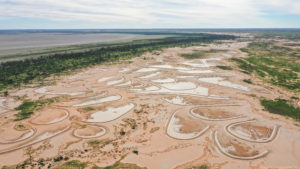How much rain do you use?

While there is good growth after the rain, there is still lots of bare soil that will allow water to run off, lots of opportunities to improve
This is a question that we constantly ask ourselves and always strive to improve the way we value our precious rainfall. This is exactly the type of question we are asking ourselves now (we have received 90+mm in the last 5 weeks), we had a good rest while it was dry, now is the time to get active and make sure we value the precious rain we have received. This can be viewed on a number of levels; infiltration into the soil, diversity of plants, amount and class of livestock grazing it and turnover of those stock.
Infiltration:
I reckon this is the most important issue here, first up you must be able to allow water into the soil at whatever rate it falls so that it can grow pasture without running off first, this is the most efficient use of rainfall. For this to happen you really need effective ground cover of vegetation as well as organic matter in the soil (carbon is a part of this), both these issues allow the soil to absorb high rates of rainfall. There are places that might need some mechanical intervention to aid the infiltration of water, at least until there is adequate vegetation to enable the natural processes to absorb the water. To harvest and best use the water that is now stored in the soil, diversity of plant species is important, so that whenever rain falls something is growing and able to use that moisture before it drops out of the root zone.
Plant diversity:
As said above, plant diversity is so very important so that you can harvest soil moisture at any time of the year. For good plant diversity you need as much diversity through your land and livestock management system as possible. By this I mean grazing paddocks at different times of the year, with different species of livestock, different classes of livestock, different grazing intensities and length of grazes. This can make management more complex, to instil some chaos in a planned system can be difficult to organise and enact.
Diversity of Livestock:
In a livestock business we have been told that you need to find out what you do well and do more of it, simple really. Under an extremely variable climate, like what we find ourselves in now, what you do well might change from year to year. While breeding livestock, especially small animals (sheep or goats) in the Southern Rangelands is normally the most profitable, that isn’t always the case. What value might we place on improving water infiltration? With this in mind having flexibility in your options, being able to manage different species, goats, sheep, cattle and different classes in the species, growing young stock, older dry stock to go with the breeders, means you can cater for most eventualities. This doesn’t mean you have small mobs of different types of stock all over the place, just might mean you have to ability to bring in a different species or class of livestock that is suited to the plants you have in your landscape. This is about harvesting the plants and having stock to sell, turning the rain into plants, into money.
Turnover, sale of stock:
Having access to a diverse range of livestock means that you can utilise the moisture and plants available, having a mix of grazers and browsers with the plant diversity to suit means that plant utilisation can be optimised. Then the inevitable happens, the stock aren’t “finished, they aren’t ready for sale”, with the access to many sale options, livestock are always ready for sale. There is always someone looking for a store article to finish, as they have a different class of feed that can take these animals to the next level. It is usually a very smart option to sell stock once they have stopped putting on weight and you think by keeping them you could risk their health and/or the health of your landscape.
Now I’m aware not everyone lives in a rangeland environment and has access to such a diverse range of plants, enabling the running of a diverse business. Which comes first though, the diverse plants enabling this to happen, or the diverse management allowing a diversity of plants to grow?

Sometimes diversity of grazing management isn’t enough, you may need mechanical intervention
